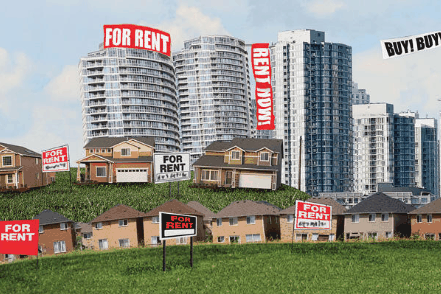
Back in August I noted how the property boosters have shifted from talking-up the prospect of rising house prices to forecasting sharply rising rents:
…price stagnation… has created a headache for the property industry. With prices now expected to flat line and rental yields well below both mortgage interest rates and term deposit rates, there is reduced incentive for first-home buyers (FHBs) and investors to enter the housing market.
Therefore, in order to re-ignite buyer interest (and maintain home values), the property industry has created the illusion that the rental market is tightening and rents are about to rise sharply.
For the past few years, housing data providers APM and RP Data have consistently forecast strong rental growth (see here for details). Likewise, in a recent interview on Switzer, the chief of BIS Shrapnel, Dr Frank Gelber, made the factually incorrect claim that “rents are rising quite aggressively because of the shortage of stock and rental yields are going up”.
And yesterday, so-called “staff writers” for News.com.au joined the fold penning the hysterically titled article:Tenants in Australian capital cities feel the heat as rents skyrocket.
The release of the latest Australian Property Monitors (APM) September Rental Market Report has once again poured cold water on the booster’s predictions that rents are about to boom. Once again, rents across most of Australia’s markets were flat to falling over the quarter:

In fact, if we take a longer view and adjust rents for inflation, most markets have achieved minimal, if any, real rental growth for two years.
First, consider real (CPI-adjusted) rents for houses:
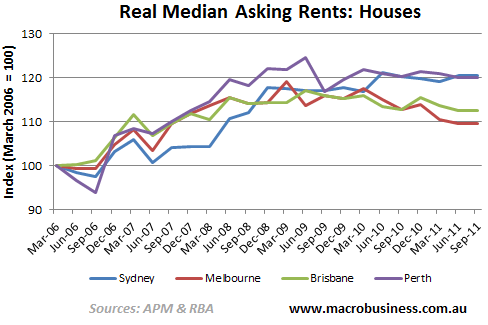
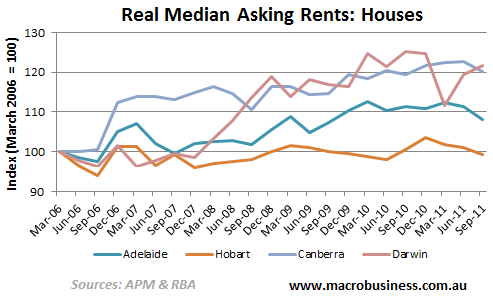
When adjusted for inflation, house rents have remained flat or fallen in Melbourne, Brisbane, Hobart and Adelaide, and have risen ever so slightly in the other capitals since September 2009.
The picture is a little different over the past two years for units, where real rents have remained flat or fallen in all capital cities except Sydney and Canberra, where unit rents have risen modestly:
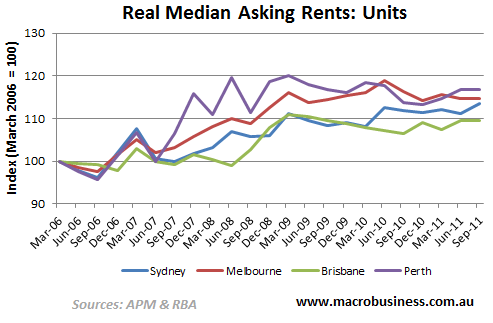
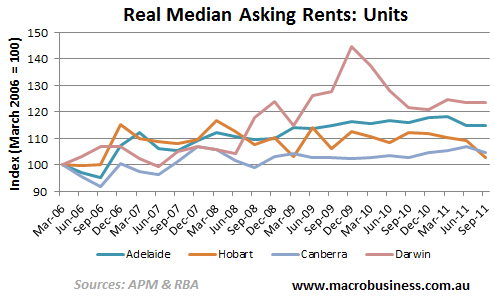
Overall, it’s a case of rents going nowhere fast. To their credit, APM have acknowledged the sluggish rental growth and have toned down their (previously bullish) rhetoric in their latest report:
The subdued growth in rental prices evident in the September quarter should continue into the December quarter as affordability constraints and cost of living pressures put a cap on the capacity of tenants to meet rental increases and concerns over the economy continues to foster a relatively conservative attitude by landlords.
Although APM still forecast growing rental yields, the improvement in yields will come more from falling prices than increasing rents:
The softening in property prices evident through 2011 has meant that gross rental yields increased marginally despite subdued capital city rental growth over the September quarter.
House rental yields should strengthen marginally as continued weak buyer demand places downward pressure on property prices at a greater rate than rental growth. Similarly unit yields should increase as rental growth outpaces prices growth for the remainder of 2011.
With home prices expected to fall further and rents to remain subdued, it will be interesting to observe the behaviour of Australia’s 1.2 million negatively geared (loss making) landlords.

